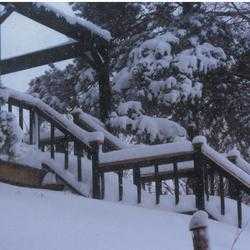The Real Scoop on Snow Cover

Norma Evans
So you have seen enough snow. At this time of year, we can all use a reminder of the benefits of snow in the garden. Since snow contains many small airspaces, it insulates and protects garden plants from the damaging effects of repeated freezing and thawing. No matter how cold it gets after a snow fall, ground temperatures vary only slightly. The temperature under 3 feet of snow can be as much as 50 F degrees warmer than the air above it.
You might think that all is dormant under a blanket of snow, but there is a lot of activity. The leaves and other dead plant material continue to break down releasing carbon dioxide that gets trapped under the snow. Many rodents survive the winter munching on whatever they can find, even on the bark of your shrubs and trees. Voles must tunnel to the surface after every snowfall to vent the CO2. Occasionally, your lawn may develop white or pink circles just after the snow melts in the spring. These are probably caused by snow mold, a fungal infection that can grow at near freezing temperatures under the snow. It loves lush, highly fertilized lawns, so lighten up on the nitrogen fertilizer. The lawn usually grows out of this problem so usually, you don't have to take any action other than not cutting the lawn too early in the spring.
The avid gardener knows that when garden soils are protected from deep frost penetration, they warm up sooner and the bulb display is earlier.
Without snow, frost penetrates deeper and deeper into the soil with possible damage to tree and shrub roots. Some garden areas receive less snow than others, such as under eaves. Taking a bit of extra time when shoveling walkways to pile snow in these areas will provide some protection there as well. Homeowners should take care, however, not to pile up a lot of snow next to the house or on any garden areas where drainage is poor. When this snow melts, it may not drain away easily and plants and bulbs may be left in excessively damp soil and plants material could be lost or damaged.
Heavy snow can damage evergreen trees and shrubs unless some protective measures are in place. Perhaps this is the time you vow that next year you will use burlap or nylon mesh wrap to keep branches of evergreens from separating. Heavy snow can accumulate on evergreen branches and weight them down creating unwanted gaps. Take a moment if you can to brush off heavy snow so there is a higher possibility that branches will spring back into place come spring.
Snow also provides free fertilizer. Nitrogen, an essential element for plant growth, is difficult to supply in steady amounts because it is a gas. Our atmosphere consists of 78% nitrogen so rain carries some of this nitrogen from the air into the soil. Sadly, much of this leaches away before it can be used. Snow on the other hand, releases nitrogen steadily as it melts. Melting snow is also a valuable source of water, and supplies a bit of phosphorus as well.
In Russia, an interesting experiment took place at the Siberian Botanical Garden. Radishes, wheat and cucumbers that were watered with melted snow grew twice as fast as the control group watered with ordinary water. The reason is complex and few of us have melted snow at hand when growing our vegetables, but it does suggest that water and snow are different at least from the gardenerís perspective.
Hopefully we will have a bright, white, clean snow cover that will melt quickly in spring.. Patchy melts and early rains arenít really an improvement over the "white stuff" and more worrisome for our dormant plants. Think snowdrops and start a few seeds indoors.